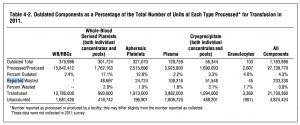Progress Report #4 (2014)
Wasted Platelet Data From The 2011 National Blood Collection and Utilization Survey Report – by Hakim
From our last presentation with Dr. Walker, he advised us to include the data about platelet wastage to strengthen our problem statement. Therefore we have met our client, Dr. Booth, to request the data to be included in our design project. Unfortunately, the data from Vanderbilt University Medical Center is classified but we can still use the data reported in The 2011 National Blood Collection and Utilization Survey Report. The data related to platelet wastage is shown in the figure below:
The total number of platelet wasted 2011 (both Whole-Blood Derived and apheresis) based on the report is 73, 421. Therefore, the loss resulted from the wastage can cost about 110 millions USD! (counted as 1 platelet bag = 1500 USD). Can you imagine what the country can do with this amount of money instead? This number of wasted platelet has increased 0.1% from 2008 and the same trend can be seen today despite many measures taken. Our design is being developed to reduce the human factor when handling the blood products, which is the main cause of platelet wastage.
The Problems with our Initial Design – by Aireen
In our initial cooler design, we designed our cooler with only two compartments where one compartment is for platelet and the other compartment is for both blood and FFP bags. The blood products will be sorted in these two compartments according to their specific storage. Our cooler will also has ventilation system to ensure the supply of oxygen to blood products. Plus, we will assemble the main circuitry system at the bottom of our cooler where we also keep in place the battery holder for scanning and sorting device.
However, after further research and discussion with Dr. Booth, we agreed that FFP and blood bags cannot be mixed together since warm FFP can destroy the blood content in the blood bags if they are to be stored together. Hence, we make some modification to our cooler design by adding one more compartment to store FFP exclusively.
Also, we eliminate the idea of installing air ventilation system in our cooler because having such system can easily contaminate our blood products stored in our cooler. Plus, we do not think ventilation is necessary since our blood products can still be viable without oxygen supply for short period of time. By eliminating this system, we also cut the building cost of our product, making the designing process more economical and more feasible.
Our New and Improvised Design – by Zulhilmi
Based on the problems stated above, we came up with a newer design that includes a couple of key elements: a) four different compartments – one RBC compartment, one platelet compartment, one warm FFP compartment, and a room temperature FFP compartment; b) simpler cooling mechanism; c) built-in scanning mechanism; and d) rotational sorting mechanism.
Our design has three main parts: a) the lid; b) the body; and c) the inner body. The lid holds the optical character recognition (OCR) scanner and acts as a holder of the blood products before being dropped into the designated compartment. The body maintains the temperature of the compartments inside it; and houses the circuitry and the arduino microcontroller. The inner body consists of the compartments and it includes the rotational sorting mechanism.
So far, we’ve decided on two different designs: rotating compartments design (left) and rotating feeder design (right).
Both designs have the same basic principle, except for the location of the feed and the location of the motor. The blood product will be inserted through the feed and scanned. The scanner is fitted onto the lid of the cooler. When the data from the scanner is received by the arduino, it will drop the blood product into the body. The bottom of the compartments will be filled with a cooling agent (dry ice, ice cubes, cold packs, etc – still in discussion) and the temperature in each compartment will be regulated by adjusting the thickness of the base of each compartment (by using heat transfer calculation).
For the rotating compartments design, the scanner will be on one side of the lid so that it will be on top of one container. The servo motor at the bottom of the inner body will rotate the compartments so that the correct compartment will be at the bottom of the feed to receive the blood product. For the rotating feeder design, the scanner will be in the middle so that it will be on top of the feeder. The servo motor at the top of the compartments will be fixed with a feeder (a slanted plane) which will channel the blood products from the feed into the correct compartment.

©2024 Vanderbilt University ·
Site Development: University Web Communications